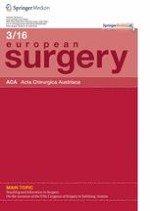Anzeige
01.06.2016 | main topic
Surgical residency in the United States–a personal European perspective
Erschienen in: European Surgery | Ausgabe 3/2016
Einloggen, um Zugang zu erhaltenSummary
Background
Surgical education requires three things: dedication, mentorship, and exposure. This is true today as it was in 1878 when Dr. William Stewart Halsted travelled through Europe and returned to the United States (U.S.) to lay the ground stone for what would be the modern U.S. residency model.
Methods
This article is intended to help understand the evolution and current state of the U.S. residency model and is written through the lens of the first author who has trained in both systems. We hope to outline some key differences that we deem particularly interesting.
Results
Concrete lessons we can learn from the U.S. system are to abolish favoritism, enroll residents in formal training programs with a set start and finish date, consider implementing midlevel practitioners and establishing a steeper hierarchy within the residency itself.
Conclusions
The U.S. model, despite all its own inherent issues, has managed to balance the three ingredients of surgical education: dedication, mentorship, and exposure. Contrarily, in many European countries medical school is followed by years of uncertainty. With demographical and societal changes this deficiency has led to many potential young surgeons turning towards other specialties and industries.
